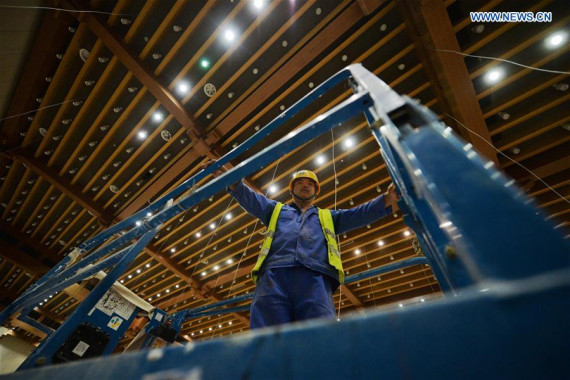
A constructor works at the main conference hall in the Silk Road International Convention Center in Dunhuang, northwest China's Gansu Province, Aug. 3, 2016. (Photo: Xinhua/Chen Bin)
Progresses in the Belt and Road Initiative and China's urbanization drive are among the bright spots in the country's efforts to fulfill targets in its development plan.
Capacity, infrastructure and education cooperation with countries under the Belt and Road Initiative have made substantial progress, said Zhao Chenxin, spokesperson for the National Development and Reform Commission (NDRC) at a news briefing.
ADVANCES IN BELT AND ROAD
The total value of bilateral industrial cooperation has exceeded 100 billion U.S. dollars under the framework. So far, Chinese companies have built 46 cooperation zones in countries along the routes, while China's Ministry of Education has inked over 60 deals with those countries.
In 2015, nearly half of the international students in China came from countries along the routes, Zhao said. Nearly 400,000 foreign students from 202 countries and regions came to study in China in 2015, data showed.
Meanwhile, China has built railways, highways and ports along the routes while signing MOUs with its neighbors and partners.
Launched in late 2013, the initiative is an umbrella term for the Silk Road Economic Belt and the 21st-Century Maritime Silk Road. It will be a trade and infrastructure network connecting Asia with Europe and Africa along ancient trade routes.
PROGRESS ON URBANIZATION GOALS
China has also made significant progress in shanty-town renovation and building affordable housing and public transportation, the spokesperson said at the same briefing.
As of the end of June, the country had met 66.9 percent of its annual shanty-town renovation target, 8.2 percentage points higher than the same period last year.
As for urban affordable housing projects, 97.9 percent of the annual target had been reached as of the end of June, Zhao said.
In the first half of 2016, city and inter-city railway networks grew rapidly. Rail transit in 25 cities reached a length of more than 3,300 kilometers, and another 3,800 km was under construction in 37 cities. The intercity traffic network hit 1,250 km.
Governments of all provincial regions have released their reform plans on the household registration system.
The central government is supporting 37 towns to innovate infrastructure investment financing and help medium and small cities and towns to improve infrastructure weak points in water, heat and gas supply as well as sewage and garbage treatment.
Zhao also said that China will strive to foster new pillars of economic growth and deepen international cooperation in its urbanization drive.
CHALLENGING CAPACITY CUTS AHEAD
However, overcapacity reduction casts a shadow over the Chinese economy. China still faces daunting challenges in reducing capacity for the rest of 2016, despite an acceleration in July, according to Zhao.
By the end of July, capacity reduction in China's steel sector totaled just 21 million tonnes, or 47 percent of the annual target, Zhao said. This marked substantial progress, as China had only completed about 30 percent of planned cuts for the year by the end of June, but it is still far from the target.
To fulfil the annual target, local governments were urged to be more resolute in cutting capacity and introducing measures such as accountability systems, public exposure and blacklisting, according to Zhao.
China had reached 38 percent of annual coal capacity reduction targets as of the end of July, Zhao added.
Zhao attributed the default largely to a spike in steel and coal prices this year and local governments' reluctance to cut capacity in order to protect jobs and local economies.
Despite the default, Zhao said China's overcapacity cutting efforts will not drag on the country's growth or harm the world economy.
Overcapacity is a global problem resulting from the 2008 financial crisis and occurs in many industries such as crude oil, iron ore and auto making, causing shale oil and gas stockpiles in the United States and iron ore overproduction in Australia, Zhao said when responding to concerns raised by a Reuters correspondent.
Even in the steel sector, overcapacity is not just a "China problem." "Many countries are confronting the problem. It is a global issue," he said. In 2014, China's rate of capacity utilization of crude steel was about the same as the world's average of 73.4 percent.
Moreover, China's iron and steel products are mainly for the domestic market to support the country's urbanization, manufacturing and infrastructure development.


















































